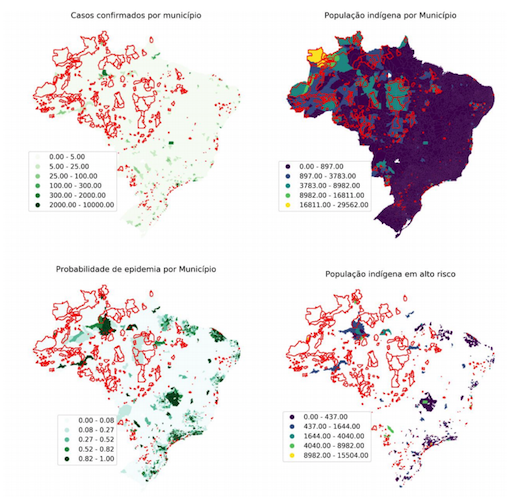Report assesses dissemination of Covid-19 among indigenous population
28/04/2020
Ricardo Valverde
A group of researchers of the Oswaldo Cruz Foundation (Fiocruz) and of the Getulio Vargas Foundation (FGV) has just released a report on the risk of Covid-19 dissemination among indigenous populations, due to the geographic and sociodemographic vulnerability of this segment of the Brazilian population. According to the study, the arrival of Covid-19 has imposed many challenges to indigenous communities, to health authorities and to society as a whole, to promote the protection of these populations against the disease, which can have great social and health impact. As the disease moves to smallest cities and the countryside, which is expected to happen in the upcoming weeks, a marked increase in the rate of indigenous populations at high risk is also expected. The researchers responsible for the report state that “the exponential growth of confirmed cases of Covid-19 in the Brazilian population and the clear movement of viral circulation towards the hinterland, in particular in the northern states of Amazonas and Amapá, is an alert for us regarding the impact of this pandemic on indigenous peoples”.
The report is the first of a series that will follow the dissemination of the epidemic in indigenous populations. The document was produced by researchers of the Nucleus of Analytic Methods for Epidemiological Surveillance of the Scientific Computation Program of Fiocruz and FGV, in a partnership with the Work Group about Sociodemographic and Epidemiologic Vulnerability of Indigenous Peoples in Brazil to the Covid-19 Pandemic of the National School of Public Health (Ensp/Fiocruz).
By integrating different databases, the report has identified the segments of indigenous populations with higher vulnerability, according to different population groups, represented by individuals residing in towns and in urban and rural areas, in towns covered by Special Indigenous Public Health Districts (DSEIs) and in Indigenous Lands officially recognized. According to the researchers, the analysis are based on the geoggraphic exposure of the indigenous population in municipalities classified according to levels of probability of epidemic, estimated for the municipal population. The report has also described socioeconomic and demographic factors potentially related to the vulnerability to Covid-19 in the population residing in Indigenous Lands.
The report shows that in the 16th epidemiologic week of 2020, of the 817,000 indigenous subjects considered in the analysis, 279,000 (34.1%) reside in municipalities at high risk (> 50%) for the Covid-19 epidemic, and 512,000 (62.7%) live in low-risk (< 25%) municipalities. Indigenous Lands (TIs) in municipalities with high probability of introduction of Covid-19 (> 50%) are mostly located near urban centers in the North and North-East of Brazil, such as Manaus, the Rio Branco-Porto Velho line, Fortaleza, Salvador, and capital cities in the South and South-East of the country.

Map 1 - Confirmed cases by municipality. Map 2 - Indigenous population by municipality. Map 3 - Probability of epidemics by municipality. Map 4 - High risk indigenous population.
Indigenous people living in urban areas reside mostly in municipalities with high risk of Covid-19, for a total of 190,767 individuals in this situation. This corresponds to 67.5% of the urban indigenous population in the Center-West region and to 79.4% in the South and South-East regions. Also according to the report, about 22% (89,000) of the rural indigenous population in Brazil reside in municipalities at high risk (> 50%) of short-term epidemic, in particular the area called Legal Amazon, with 21.1% of its rural population in this condition. The population residing in Indigenous Lands has a very similar pattern to that of the total rural indigenous population. The time trend of cases and deaths confirmed for Covid-19 in municipalities located in territories of the Special Indigenous Public Health Districts (DSEIs) shows a pattern that differs from the one observed for the average Brazilian municipality. The Legal Amazon area has the second highest rate of cases and deaths, with more than 50% of the confirmed cases in the region. The highest rate is in the South and South-East regions.
Brasília stands out in the Center-West region as an area of intense disease activity. The Brazilian capital attracts many indigenous individuals, resulting in high dissemination potential for Covid-19 to indigenous villages, in the Center-West region as well as in other areas in the country. Hospitalization cases for Severe Acute Respiratory Syndrome (SARS) among indigenous populations has been increasing when compared to its historical patterns. The report points to an increase in the proportion of hospitalizations of indigenous individuals in the Legal Amazon area and a change in the pattern of hospitalization per age group, suggesting active disease in indigenous individuals in the country.
According to physician Andrey Moreira Cardoso, researcher of the National School of Public Health (Ensp/Fiocruz) and of the Work Group of Indigenous Health of the Brazilian Association of Collective Health (Abrasco), indigenous peoples have higher vulnerability from the epidemiologic point of view. “There are various international studies comparing the situation of indigenous peoples in different regions of the world, showing they are always at an economic, social and health-related disadvantage when compared to other groups in the same locations. This also happens in Brazil”.
Read here the full report (in Portuguese).




